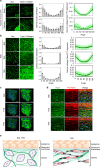Tissue-scale tensional homeostasis in skin regulates structure and physiological function
- PMID: 33127987
- PMCID: PMC7603398
- DOI: 10.1038/s42003-020-01365-7
Tissue-scale tensional homeostasis in skin regulates structure and physiological function
Abstract
Tensional homeostasis is crucial for organ and tissue development, including the establishment of morphological and functional properties. Skin plays essential roles in waterproofing, cushioning and protecting deeper tissues by forming internal tension-distribution patterns, which involves aligning various cells, appendages and extracellular matrices (ECMs). The balance of traction force is thought to contribute to the formation of strong and pliable physical structures that maintain their integrity and flexibility. Here, by using a human skin equivalent (HSE), the horizontal tension-force balance of the dermal layer was found to clearly improve HSE characteristics, such as the physical relationship between cells and the ECM. The tension also promoted skin homeostasis through the activation of mechano-sensitive molecules such as ROCK and MRTF-A, and these results compared favourably to what was observed in tension-released models. Tension-induced HSE will contribute to analyze skin physiological functions regulated by tensional homeostasis as an alternative animal model.
Conflict of interest statement
T.T. is a supreme technical advisor at Organ Technologies Inc. This work was partially performed under the condition of an Invention Agreement between RIKEN, Rohto Pharmaceutical Co., Ltd., Meiji Seika Pharma Co., Ltd. and Organ Technologies Inc. The remaining authors declare no competing interests.
Figures






Similar articles
-
Tensional homeostasis in dermal fibroblasts: mechanical responses to mechanical loading in three-dimensional substrates.J Cell Physiol. 1998 Jun;175(3):323-32. doi: 10.1002/(SICI)1097-4652(199806)175:3<323::AID-JCP10>3.0.CO;2-6. J Cell Physiol. 1998. PMID: 9572477
-
[Dermo-epidermal interactions and skin pharmacology].Pathol Biol (Paris). 1992 Feb;40(2):139-46. Pathol Biol (Paris). 1992. PMID: 1608655 Review. French.
-
Y-27632 preserves epidermal integrity in a human skin organ-culture (hSOC) system by regulating AKT and ERK signaling pathways.J Dermatol Sci. 2019 Nov;96(2):99-109. doi: 10.1016/j.jdermsci.2019.10.006. Epub 2019 Nov 3. J Dermatol Sci. 2019. PMID: 31718896
-
The use of an in vitro wound healing model, the tri-layered skin equivalent, to study the effects of cytokines on the repopulation of the wound defect by fibroblasts and keratinocytes.Biochem Soc Trans. 1997 May;25(2):369S. doi: 10.1042/bst025369s. Biochem Soc Trans. 1997. PMID: 9191413 No abstract available.
-
Mechanobiology of force transduction in dermal tissue.Skin Res Technol. 2003 Feb;9(1):3-23. doi: 10.1034/j.1600-0846.2003.00358.x. Skin Res Technol. 2003. PMID: 12535279 Review.
Cited by
-
In-Vitro Study of Indium (III) Sulfate-Containing Medium on the Viability and Adhesion Behaviors of Human Dermal Fibroblast on Engineered Surfaces.Materials (Basel). 2023 May 18;16(10):3814. doi: 10.3390/ma16103814. Materials (Basel). 2023. PMID: 37241441 Free PMC article.
-
Fabrication of Multiscale, Multidirectional Orientated Collagen Hydrogels with Guided Cell Alignment Using Fluidics and a Three-Dimensional Printing.ACS Biomater Sci Eng. 2025 May 12;11(5):2875-2887. doi: 10.1021/acsbiomaterials.4c02156. Epub 2025 Apr 18. ACS Biomater Sci Eng. 2025. PMID: 40251729 Free PMC article.
-
Probiotic Adhesion to Skin Keratinocytes and Underlying Mechanisms.Biology (Basel). 2022 Sep 19;11(9):1372. doi: 10.3390/biology11091372. Biology (Basel). 2022. PMID: 36138851 Free PMC article.
-
Unveiling the Role of Sweet Potato Root in Skin Health: A New Approach to Collagen Synthesis and Rejuvenation.Food Sci Nutr. 2025 May 25;13(6):e70281. doi: 10.1002/fsn3.70281. eCollection 2025 Jun. Food Sci Nutr. 2025. PMID: 40444118 Free PMC article. Review.
-
Applications of Engineered Skin Tissue for Cosmetic Component and Toxicology Detection.Cell Transplant. 2024 Jan-Dec;33:9636897241235464. doi: 10.1177/09636897241235464. Cell Transplant. 2024. PMID: 38491929 Free PMC article. Review.
References
Publication types
MeSH terms
Substances
LinkOut - more resources
Full Text Sources
Other Literature Sources

